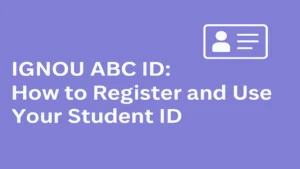Introduction: The Importance of Effective Exam Paper Solving Techniques
Exams are a crucial part of academic life, especially when it comes to the Indira Gandhi National Open University (IGNOU) exams. For many students, the thought of facing a large, unfamiliar question paper can cause a great deal of stress. However, the key to overcoming this anxiety lies in mastering effective exam paper-solving techniques.
The art of solving an IGNOU exam paper is more than just having the right knowledge; it’s about knowing how to apply that knowledge effectively during the exam. This guide will help you sharpen your strategies, improve your time management, and optimize your performance so you can walk into the exam hall with confidence. 🚀
Understanding the IGNOU Exam Structure
Before diving into specific techniques, it’s essential to understand the structure of the IGNOU exam. This knowledge will help you craft a strategy that targets the most important areas effectively.
Types of Questions in IGNOU Exams (MCQs, Descriptive, etc.)
IGNOU exams typically consist of multiple-choice questions (MCQs) and descriptive questions. While MCQs focus on testing your conceptual knowledge, descriptive questions aim to gauge your ability to express your understanding in written form.
- MCQs: These questions are relatively straightforward but can become tricky if you don’t have a good understanding of the subject.
- Descriptive Questions: Here, you need to structure your answers logically and ensure you include relevant examples to support your point.
Understanding the mix of question types will help you allocate time wisely during the exam.
Marking Scheme and Time Allocation
Each section of the paper is allotted a specific number of marks. It’s essential to allocate your time in proportion to the marks each section carries. If you are well-prepared, you will be able to complete the exam on time while maximizing your marks.
Key Areas to Focus on in Each Paper
- Core Topics: Make sure to revise all the core topics, as these are the foundation for most exam papers.
- Weightage of Topics: Look at previous year’s papers to understand the weightage of various topics, and focus on high-priority sections. 🔍
Pre-Exam Preparation: Setting the Foundation for Success
Good exam paper solving starts long before you sit for the actual exam. Proper preparation can significantly affect your performance.
How to Organize Your Study Plan
A well-structured study plan is your first step toward success. Create a realistic schedule that divides your time between study sessions, breaks, and revisions. Focus on active learning, which involves solving sample papers, engaging with peers, and even teaching the concepts to someone else.
Importance of Revision and Practice Papers
Revision plays a critical role in solidifying your knowledge and boosting your confidence. By going over your notes, textbooks, and assignments, you make sure that all the information is fresh in your mind.
Moreover, solving practice papers allows you to familiarize yourself with the types of questions that may appear in the exam, helping you improve your response times.
How to Analyze Previous Year Papers for Pattern Recognition
By going through past papers, you’ll get an idea of the question patterns and common topics that tend to repeat. This can provide valuable insights into which areas need more attention. You’ll also learn the level of difficulty for each topic.
The Role of IGNOU Study Materials in Paper Solving
IGNOU provides official study materials, which are carefully aligned with the syllabus and exam format. Make sure to prioritize these materials as they cover the essential topics in-depth.
Time Management: The Key to Effective Paper Solving
Time management is arguably the most crucial factor in performing well on any exam, and this holds true for IGNOU exams as well.
How to Divide Your Time Across Sections
It’s essential to divide your time effectively across sections. For instance, if the MCQ section is worth 40 marks and the descriptive section is worth 60, spend more time on the descriptive section. A general rule of thumb is to spend 1-2 minutes per MCQ and 15-20 minutes per descriptive question.
Setting Time Limits for Each Question
Set time limits for each question before you start writing. This prevents you from spending too much time on one question at the expense of others. Set a timer and stick to the allocated time.
The Importance of Practicing Under Time Constraints
Simulate exam conditions during your practice sessions by solving papers within the allocated time frame. This will help you develop an internal clock for pacing yourself during the real exam.
How to Handle Unexpected Time Issues During the Exam
Sometimes, you may encounter unexpected problems during the exam, such as a tricky question that takes longer to answer. In these cases, it’s essential to keep calm and move on to the next question. You can always come back to the difficult question later if time permits.
Answer Presentation: How to Score Maximum Marks
Your knowledge is essential, but how you present your answers can make a huge difference in your score. A clear, concise, and structured answer will always score better than a messy or vague one.
Writing Clear and Concise Answers
Be as precise as possible in your answers. Focus on the main points and avoid unnecessary elaboration that might dilute the effectiveness of your response. Use short paragraphs, bullet points, and headings to make your answer more readable.
Importance of Structuring Your Answer Properly
For long-form descriptive questions, structuring your answer logically is key. Start with a brief introduction, followed by the main body, and end with a concise conclusion. This format makes it easier for the examiner to follow your thought process.
The Role of Bullet Points, Subheadings, and Diagrams
Bullet points and subheadings help break up long paragraphs and make your answer more organized. Diagrams (when relevant) can illustrate your understanding clearly, especially for subjects that involve processes or mechanisms.
How to Ensure Clarity in Descriptive Answers
Ensure that your writing is clear and easy to follow. Use proper grammar and sentence structure to avoid confusion. Additionally, avoid using too many jargon terms unless necessary, and always explain them if you do.
Tackling Multiple Choice Questions (MCQs)
MCQs are a significant part of the IGNOU exam. Although they may seem easy, they require strategic thinking and quick decision-making.
Key Strategies for Solving MCQs Effectively
- Eliminate wrong answers: Start by crossing out the obviously incorrect options, which increases your chances of selecting the right one.
- Use logic and reasoning: Even if you don’t know the exact answer, use your knowledge of the subject to make an educated guess.
How to Eliminate Wrong Answers Quickly
If you’re unsure about an answer, consider each option and eliminate the ones that are factually incorrect or don’t make sense. This narrows down your choices and improves your odds of selecting the right one.
Common Mistakes to Avoid in MCQ Paper Solving
- Not reading the question carefully: This can lead to misunderstanding the question, which may cause you to select an incorrect answer.
- Overthinking: Sometimes, the first answer that comes to mind is the right one. Don’t second-guess yourself too much.
When to Guess and When to Skip
- Guessing: When you can eliminate at least two options, guess! Your odds of getting it right increase significantly.
- Skipping: If you have no idea, skip the question and return to it later.
Handling Descriptive Questions: Tips for Detailed Answers
Descriptive questions are an opportunity to showcase your knowledge and writing skills. Here’s how to approach them for maximum marks.
How to Approach Essay-Type Questions
For essay-type questions, start with an outline. Organize your thoughts before diving into writing. Ensure that your introduction sets the context, the body covers the main points, and the conclusion ties everything together.
Strategies for Writing Long-Form Answers
When writing long answers, focus on clarity and coherence. Start by highlighting the key points in your response, and then elaborate on them one by one. Make sure to stay relevant and avoid unnecessary diversions.
Tackling Case Studies and Scenario-Based Questions
Case studies and scenario-based questions in IGNOU exams require a combination of analytical skills and practical knowledge. Here’s how to approach them effectively.
Understanding the Case Study Approach in IGNOU Exams
Case studies usually present real-world situations or problems related to your subject. These questions test your ability to apply theoretical knowledge to solve practical issues. The key here is not just recalling facts but also demonstrating a logical approach to problem-solving.
Key Strategies for Analyzing and Solving Case Studies
- Read the case carefully: Identify the main issues, challenges, and the objectives of the case study.
- Break it down: Divide the case study into smaller, more manageable components (e.g., problem identification, analysis, solutions).
- Provide evidence: Support your answers with relevant theories, models, or examples from your study materials.
How to Organize Your Thoughts for Case Study Responses
Start with a brief introduction of the case, followed by a detailed analysis of the issues. Then, provide solutions or recommendations, ensuring that each step is logically connected to the previous one. Finish with a concise conclusion.
Common Mistakes in Case Study Questions
- Not addressing the specific problem: Ensure that your response directly answers the problem posed in the case study.
- Overlooking the provided data: The data in the case is critical for analysis. Don’t ignore any specific figures or points.
- Generalizing your solutions: Tailor your solutions to the specifics of the case instead of offering generic advice.
Writing Effective Conclusions for Descriptive Papers
A strong conclusion can be the final push that sets your answer apart from others. It’s your chance to summarize and reinforce your arguments.
Why a Strong Conclusion Can Make a Difference
A conclusion leaves a lasting impression on the examiner. It can emphasize the strength of your argument and demonstrate a well-rounded understanding of the topic.
Key Elements of a Good Conclusion
- Restate the thesis: Briefly recap the main point of your answer without repeating the entire argument.
- Summarize key points: Highlight the most critical aspects of your answer.
- Final thoughts: Offer a perspective, solution, or future direction related to the topic.
How to Summarize Without Repeating Information
Avoid merely rephrasing your introduction or repeating the content of your answer. Instead, distill the key insights and tie them back to your main argument.
Best Practices for Concluding Your Answers
- Be concise: Don’t drag the conclusion on unnecessarily.
- Ensure coherence: The conclusion should flow naturally from the body of your answer.
- Tie it back to the question: Make sure your conclusion addresses the exam question directly.
Dealing with Difficult Questions: How to Tackle the Toughest Parts
At some point, you will face questions that seem challenging or unfamiliar. Here’s how to handle them without getting overwhelmed.
The Importance of Staying Calm and Focused
One of the most important skills during the exam is the ability to stay calm. When you encounter a difficult question, don’t panic. Take a deep breath and think logically. Panic can cloud your judgment, leading to mistakes.
How to Break Down Complex Questions into Manageable Parts
When faced with a complex question:
- Identify the key components: Break the question into smaller parts.
- Address one part at a time: Solve each section step by step rather than trying to answer the whole question at once.
Strategies for Handling Questions You Don’t Know
If you don’t know the answer to a question:
- Write what you know: Jot down any relevant concepts, keywords, or related information.
- Make educated guesses: Use your general knowledge and reasoning skills to eliminate obviously wrong answers.
How to Use Logic and Reasoning When Stuck
If you’re stuck, use logical reasoning to make an educated guess. Often, even a poorly answered question with logical explanations can earn partial marks. Focus on showing your understanding rather than aiming for perfection.
Review and Proofreading: The Final Step to Perfect Answers
After completing the exam paper, it’s crucial to review your work. This final check ensures that you’ve answered all parts of the question and that there are no mistakes.
Why You Should Always Leave Time for Review
You might feel tempted to rush through the paper, especially when time is tight, but always leave 10-15 minutes at the end to review your answers. This can help you spot simple mistakes, such as grammatical errors or missed points.
How to Spot Common Mistakes During Proofreading
During your review:
- Check for spelling and grammatical errors.
- Ensure your answers are clear and logically structured.
- Cross-check your calculations or figures if relevant to your subject.
The Importance of Neatness in Your Paper
Make sure your handwriting is legible and your answers are presented clearly. Neatness in your paper adds to the overall impression you leave with the examiner.
Checking for Answer Completeness
Before submitting your paper, ensure you haven’t skipped any questions and that your answers are completely addressed. A partially answered question will not earn full marks.
Stress Management During the Exam
Managing stress is vital for performing well in exams. Learning to stay calm and focused can help you solve problems more efficiently and improve your overall performance.
How to Avoid Panic and Stay Calm During the Exam
Exam anxiety is common, but learning how to control it can significantly impact your performance. Techniques such as deep breathing, positive visualization, and staying focused on one question at a time can reduce stress.
Breathing Exercises to Reduce Exam Anxiety
- Deep breathing: Take slow, deep breaths to reduce heart rate and calm the mind.
- Box breathing: Inhale for 4 counts, hold for 4 counts, exhale for 4 counts, and hold for 4 counts. Repeat.
The Role of Positive Thinking in Exam Performance
Positive thinking can enhance your confidence and keep you focused. Instead of worrying about failing, remind yourself of your preparation and past successes. Self-affirmations can reduce anxiety.
How to Reframe Negative Thoughts During the Exam
If you start feeling negative, reframe those thoughts. Instead of thinking “I can’t answer this question,” say, “I will give it my best shot, and I can figure it out.”
Post-Exam Strategies: What to Do After Completing Your Paper
Once you finish the exam, it’s important to manage your emotions and thoughts effectively.
How to Relax and Decompress After the Exam
- Take a break: Go for a walk or engage in a hobby to clear your mind.
- Celebrate: Acknowledge the effort you put in, regardless of how you feel the exam went.
Reflecting on Your Performance for Future Improvements
After a brief break, reflect on how the exam went. What strategies worked well? What areas need improvement for future exams?
Handling Post-Exam Anxiety
It’s natural to feel anxious after an exam, but don’t dwell on what you think you could have done better. Stay focused on what you can control and avoid unnecessary stress.
Common Mistakes to Avoid While Solving IGNOU Exam Papers
To maximize your score, you should be aware of the common pitfalls that students often fall into.
Rushing Through the Paper
While time management is crucial, rushing through the paper can lead to careless mistakes. Take the time to think through each question before answering.
Not Following the Question Format Properly
Always ensure that you follow the specific instructions for each section. Ignoring these can result in loss of marks, even if the content of your answer is correct.
Ignoring the Instructions or Guidelines
Pay close attention to word limits, formatting instructions, and other specific directions. Failing to follow these guidelines can negatively impact your score.
Mismanaging Time on Unfamiliar Topics
While it’s natural to be tempted to spend extra time on a difficult question, be mindful of the overall time. If you don’t know the answer, it might be best to move on to easier questions first.
Conclusion: Mastering Paper Solving Techniques for IGNOU Exams
Mastering the art of solving IGNOU exam papers is about more than just preparation; it’s about having a strategy for every step of the exam process. From planning your study schedule to managing your time during the exam and maintaining your composure, each technique plays a critical role in helping you succeed.
Remember, the goal is not just to study hard but to study smart. By using the techniques outlined above, you’ll be equipped to handle any exam paper confidently and efficiently. Good luck, and may your hard work pay off! 🌟
FAQs
How can I manage my time effectively during the IGNOU exam?
Effective time management is crucial for IGNOU exams. To manage your time:
Prioritize questions based on difficulty. Start with questions you’re confident about.
Allocate a fixed amount of time to each question and stick to it.
Leave 10-15 minutes at the end to review your answers and make corrections.
Avoid spending too much time on difficult questions. Move on and come back to them if you have time left.
How do I deal with a difficult case study in the exam?
When faced with a difficult case study:
Read the case carefully and underline the key points.
Break down the case into smaller sections: Identify the problem, analyze it, and provide solutions.
Use relevant theories or models to support your answers.
Don’t panic—start with what you know, and address each part of the case methodically.
What are some tips for writing clear and concise answers?
To write clear and concise answers:
Stick to the point: Avoid unnecessary elaboration or repetition.
Use bullet points or numbered lists to present information clearly.
Be structured: Start with a brief introduction, followed by the main body, and end with a conclusion.
Ensure your handwriting is legible and avoid clutter on the page
How can I improve my exam performance with regular practice?
Regular practice can significantly improve your exam performance:
Solve previous years’ question papers to familiarize yourself with the exam pattern.
Mock tests: Take timed mock tests to practice time management and improve your ability to handle pressure.
Review: After solving papers, review your answers to identify areas for improvement and correct any mistakes.
Focus on weak areas: Dedicate extra time to topics or question types that you find challenging.
What should I do if I don’t know the answer to a particular question?
If you don’t know the answer to a question:
Don’t panic—keep calm and move on to another question.
Use logic: Try to recall related concepts and make educated guesses based on your general knowledge.
Write down whatever you know: Even partial answers can earn you marks.
Once you’ve finished the rest of the paper, return to the question and see if you can recall more information.
Related Posts:
- IGNOU Exam Time Table 2025: A Comprehensive Guide to Download
- Download IGNOU Previous Year Question Papers Online: Best Guide 2025
- IGNOU Study Materials 2025: Your Key to Success in Distance Education
- IGNOU Enrollment Number: A Comprehensive Guide 2025
- IGNOU 2nd Year Admission 2025: Your Comprehensive Guide to Smooth Enrollment
- IGNOU Vacancy 2025: Opportunities and Updates, Comprehensive Guide




